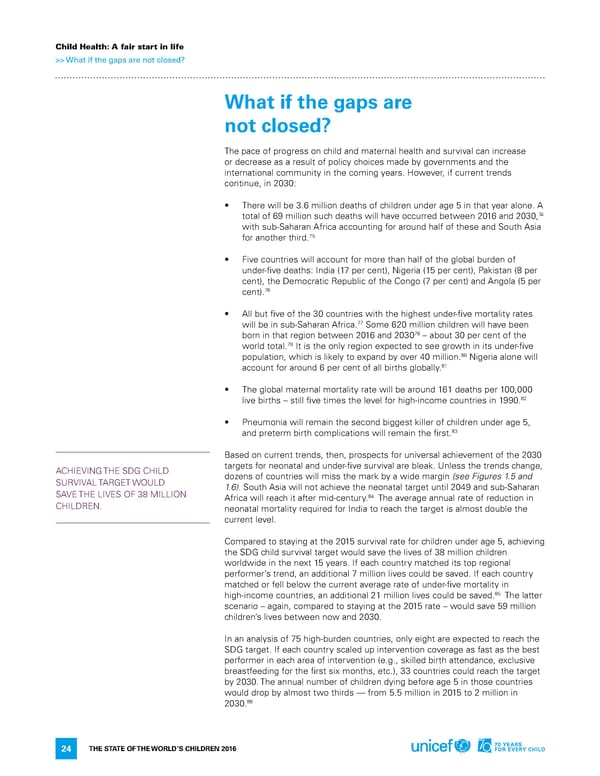Child Health: A fair start in life >> What if the gaps are not closed? What if the gaps are not closed? The pace of progress on child and maternal health and survival can increase or decrease as a result of policy choices made by governments and the international community in the coming years. however, if current trends continue, in 2030: • There will be 3.6 million deaths of children under age 5 in that year alone. a 74 total of 69 million such deaths will have occurred between 2016 and 2030, with sub-Saharan africa accounting for around half of these and South asia 75 for another third. • five countries will account for more than half of the global burden of under-five deaths: india (17 per cent), nigeria (15 per cent), Pakistan (8 per cent), the democratic republic of the Congo (7 per cent) and angola (5 per cent).76 • all but five of the 30 countries with the highest under-five mortality rates 77 will be in sub-Saharan africa. Some 620 million children will have been born in that region between 2016 and 203078 – about 30 per cent of the 79 world total. it is the only region expected to see growth in its under-five 80 population, which is likely to expand by over 40 million. nigeria alone will account for around 6 per cent of all births globally.81 • The global maternal mortality rate will be around 161 deaths per 100,000 live births – still five times the level for high-income countries in 1990.82 • Pneumonia will remain the second biggest killer of children under age 5, and preterm birth complications will remain the first.83 Based on current trends, then, prospects for universal achievement of the 2030 aChieVinG The SdG Child targets for neonatal and under-five survival are bleak. Unless the trends change, SUrViVal TarGeT WoUld dozens of countries will miss the mark by a wide margin (see Figures 1.5 and SaVe The liVeS of 38 Million 1.6). South asia will not achieve the neonatal target until 2049 and sub-Saharan africa will reach it after mid-century.84 The average annual rate of reduction in Children. neonatal mortality required for india to reach the target is almost double the current level. Compared to staying at the 2015 survival rate for children under age 5, achieving the SdG child survival target would save the lives of 38 million children worldwide in the next 15 years. if each country matched its top regional performer’s trend, an additional 7 million lives could be saved. if each country matched or fell below the current average rate of under-five mortality in 85 high-income countries, an additional 21 million lives could be saved. The latter scenario – again, compared to staying at the 2015 rate – would save 59 million children’s lives between now and 2030. in an analysis of 75 high-burden countries, only eight are expected to reach the SdG target. if each country scaled up intervention coverage as fast as the best performer in each area of intervention (e.g., skilled birth attendance, exclusive breastfeeding for the first six months, etc.), 33 countries could reach the target by 2030. The annual number of children dying before age 5 in those countries would drop by almost two thirds — from 5.5 million in 2015 to 2 million in 2030.86 The STaTe of The World’S Children 2016 24
 70 Years for Every Child Page 38 Page 40
70 Years for Every Child Page 38 Page 40